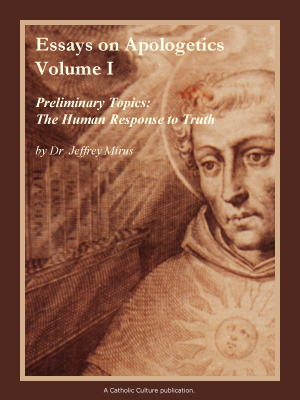Does abstinence cause pregnancy? The Times makes the argument
By Phil Lawler ( bio - articles - email ) | Jan 28, 2010
The pregnancy rate among American teenagers (aged 15-19) rose in 2006—the last year for which statistics are available—after a decade of decline. The increase was relatively small (3%), and may indicate only a temporary reversal of the positive trend. Still the statistic is cause for concern.
Writing in the New York Times, Tamar Lewin provides the party line in the first paragraph of her story, announcing that the new data are “likely to intensify the debate over federal financing for abstinence-only sex education.”
That didn’t take long, did it? We have one isolated piece of information: an uptick in teen pregnancies. We could probably come up with dozens of hypotheses to explain the trend (if indeed it is a trend). Maybe it was a difference in the way the data were compiled. Maybe it was burst of teen sexual activity. Maybe it was sun spots. Who knows? But Tamar Lewin offers her preferred theory right in her lede: it was that old devil abstinence education.
Leaving aside the rather obvious fact that abstinence doesn’t cause pregnancy, let’s take a closer look at the facts.
The federal government has been financing abstinence education since the Clinton administration. So if these programs lead to an increase in teen-pregnancy rates, you’d expect the statistics to show an increase in pregnancy beginning around 1990. But that’s not what the numbers show. On the contrary, teen-pregnancy rates began dropping around 1990, after an alarming rise over the previous 20 years.
Now what had been happening during those earlier years, 1970-1990? The government was heavily subsidizing “traditional” sex-ed programs, of the King Condom variety. And teen pregnancy rates had been climbing. Hmmm. Interesting. Then, at roughly the same time that Uncle Sam began supporting abstinence education as well, the pregnancy rates began to decline. Hmmm. More interesting.
Should we conclude that the federal support for abstinence education caused the decline in teen pregnancy rates? Probably not; at least the data provided in this particular story don’t support that conclusion. Just because Tamar Lewin jumps to a conclusion, that doesn’t mean we should do the same. There was a trend. We don’t yet know the reasons for the trend. What we do know, however, is that the timing of the trend weighs heavily against the suggestion that federal support for abstinence education leads to a rise teen pregnancy.
To tell the truth (which the Times story does not do), it’s unlikely that federal subsidies for abstinence education would have any powerful impact, good or bad, on the overall pregnancy rate. Because, you see, the federal support for abstinence education was never more than a fraction of the support provided for the old King Condom programs. At its peak during the Bush II administration, funding for abstinence education represented only about $1 for every $4 given to “safe sex” programs.
Still, even $1 given to an abstinence program is a dollar that isn’t available for Planned Parenthood and its allies. Having enjoyed a monopoly on sex-ed funding for so long, the PP lobby has always resented the abstinence proponents.
If your information came only from the New York Times report, you could be forgiven for thinking that the federal government supported only abstinence education, eschewing all other forms of sex education. Not so. The safe-sex programs get dollars while the chastity-oriented programs get quarters. If federal support is having any impact, then, it’s logical to start with the assumption that the safe-sex programs account for most of that impact.
Tamar Lewin starts from a different assumption, and it’s easy to understand why:
While it is difficult to pinpoint precisely how different factors influence teenage sexual behavior, some experts speculate that the rise in teenage pregnancy might be partly attributable to the $150 million a year of federal financing for sex education that emphasized abstinence until marriage, avoiding all mention of the possible benefits of contraception.
And who are these “experts” who offer such speculation? In the next paragraph Lewin provides a single quote, from that noted “expert” Cecile Richards, the president of the Planned Parenthood Federation. It’s funny that Lewin couldn’t find a single witness to testify in favor of the abstinence programs. Maybe the people who run those programs didn’t answer her calls. Come to think of it, if I were in their shoes, I wouldn’t answer her, either.
All comments are moderated. To lighten our editing burden, only current donors are allowed to Sound Off. If you are a current donor, log in to see the comment form; otherwise please support our work, and Sound Off!
-
Posted by: frjpharrington3912 -
Feb. 01, 2010 8:50 PM ET USA
I hope this article has been sent to the editor of the New York Times to show just how shallow is Lewin's analysis of the rise in teenage pregnancy. Lewin has a cynical and pessimisstic view of teenages. By presupposing that they are incapable of sexual abstinence she is saying that they are not rational beings capable of making moral judgements between good and evil, of discerning truth from error. Lewin is one of those so called "experts" who administer the poison while they devise the remedy.
-
Posted by: -
Jan. 30, 2010 6:32 PM ET USA
Are all these "teenagers" unmarried? We think highschoolers, but ages 18-19 could encompass young married people. Do people that age still marry? Just wondering if that one of the categories and if it was at all significant...
-
Posted by: -
Jan. 30, 2010 12:09 PM ET USA
Thanks for the commentary on the NYT article. It struck me that the article fails to mention the 800lb gorilla in the living room: single parenthood. The study controlled for race, but there was no control for marital/family status. My guess is at least 80% of teen-pregnancies, whether they're carried to term or aborted, occur in single-parent homes. "Sex-ed" of whatever kind will never compensate for the life-lessons learned in an intact, engaged, loving, faithful two-parent family.








